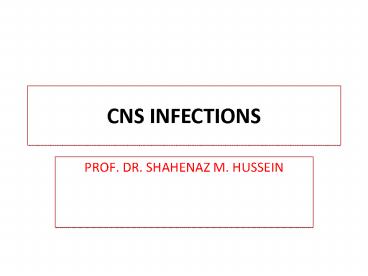CNS INFECTIONS - PowerPoint PPT Presentation
1 / 21
Title:
CNS INFECTIONS
Description:
CNS INFECTIONS PROF. DR. SHAHENAZ M. HUSSEIN OBJECTIVES By the end of this lecture you will be able to understand the followings: Etiology, clinical manifestations ... – PowerPoint PPT presentation
Number of Views:102
Avg rating:3.0/5.0
Title: CNS INFECTIONS
1
CNS INFECTIONS
- PROF. DR. SHAHENAZ M. HUSSEIN
2
OBJECTIVES
- By the end of this lecture you will be able to
understand the followings - Etiology, clinical manifestations,
investigations, and treatment of acute bacterial
meningitis. - Etiology, clinical manifestations, laboratory
findings, diagnosis and management of
encephalitis. - Slide and video demonstration of some
neurological manifestations.
3
Acute Bacterial Meningitis
- Etiology
- First 2 months of life Group B Streptococcus,
gram negative bacilli, S. pneumoniae, Neisseria
meningitides, Haemophilus influenzae type b. and
L. monocytogenes. - Children 2 mo-12yr of age 1- S. pneumoniae
- 2-
N. meningitides - Alterations of host defense
- Pseudomonas aeruginosa, Staphylococcus aureus,
Salmonella spp., and L. monocytogenes. - Mode of infection Bacterial meningitis most
commonly results from hematogenous dissemination
of microorganisms from a distant site of
infection.
4
- Clinical Manifestations The onset of acute
bacterial meningitis has two predominant
patterns - 1- The more dramatic less common presentation is
sudden onset with rapidly progressive
manifestations of shock, purpura, DIC,
unconsciousness, and frequently resulting in
death within 24 hours. - 2- More often, meningitis is preceded by several
days of fever with upper respiratory or GIT
symptoms followed by nonspecific signs of CNS
infection such as lethargy or irritability. - Non specific findings Fever,
anorexia, poor feeding, myalgia, arthralgia,
tachycardia, hypotension, and petechiae,or an
erythematous macular rash.
5
(No Transcript)
6
(No Transcript)
7
- Signs of meningeal irritation
- Nuchal rigidity and back pain
- Kernigs sign flexion of the hip 90 degrees with
subsequent pain and limitation with extension of
the leg. - Brudzinski sign involuntary flexion of the knees
and hips after passive flexion of the neck while
the patient in supine position. - Symptoms and Signs of increased ICP
- 1- Headache, and vomiting
- 2- Bulging fontanel or widening of the sutures
- 3- Cranial nerve neuropathies.
- 4- Hypertension with bradycardia
- 5- Apnea or hyperventilation, stupor and coma.
8
(No Transcript)
9
(No Transcript)
10
(No Transcript)
11
(No Transcript)
12
- Seizures (focal or generalized) due to,
cerebritis, infarction or electrolyte
disturbances. Seizures that occur on presentation
or within the first 4 days of onset are usually
of no prognostic significance. - Diagnosis
- Lumbar puncture for CSF analysis should be
performed - 1- Microorganisms on gram stain and culture.
- 2- Neutrophil pleocytosis (300-2000/mm3).
- 3- Elevated protein (100-500mg/dL)
- 4- Reduced glucose concentration (lt50 of S.
glucose) - 5- Physical appearanceTurbid with elevated
pressure (100-300 mm H2O). - Normal CSF shows Normal pressure (50-80 mm H2O),
leucocytes (lt5/mm3), proteins (20-45 mg/dl) and
glucose (75 of the level of serum glucose).
13
COMPLICATIONS
- Deafness
- Hydrocephalus
- Brain abscess
- Subdural effusion
- Motor disabilities
14
- Treatment 1- Initial Antibiotic
Therapy - -Ampicillin 200mg/kg with either cefotaxime or
ceftriaxone100mg/kg, if gram-ve bacilli present
give Ampicillin with Gentamycin for neonatal
meningitis. - -Vancomycin 60mg/kg/24hr given every 6 hr in
combination With either cefotaxime (200mg/kg/24hr
given every 6 hours) or ceftriaxone
(100mg/kg/24hr once or twice daily) in older
infants and children. - -Patients allergic to ß- Lactam antibiotics can
be treated with chloramphenicol, 100mg/kg/d,
given every 6 hr. Duration of therapy At
least for 7-14 days I.V. - -Corticosteroids I.V dexamethasone 0.15
mg/kg/dose given every 6hr for 2 days for
children older than 6wk with acute bacterial
meningitis caused by H. influenzae type b to
decrease the permanent auditory nerve damage.
15
- 2-Supportive and symptomatic therapy
A-Good evaluation and monitoring are
essential. - B-Correction of dehydration and electrolyte
disturbances and proper nutrition. - C-Control of seizures
- D- Management of neurological complications
- Prevention
- - Vaccination and antibiotic prophylaxis for
susceptible at risk contacts. - Close contact should be treated with Rifampin
10mg/kg/dose every 12hr, for 2 days (in N.
meningitides) and 20mg/kg/day for 4 days in H.
influenzae type b.
16
- ENCEPHALITIS
- Definition Infection involving cerebral
parenchyma, in some patients the meninges
involved with the parenchyma causing
meningoencephalitis. - Etiology
- 1- Arthropod born virus Arbovirus Flavivirus
- -St. Louis encephalitis. Birds (culex
mosquitoes).West-Nile virus. - - Western equine encephalitis.Birds (Colisata
mosquitoes). - - Eastern equine encephalitis. Birds ( Culisata
mosquitoes). - - Venezuelan equine encephalitis. Hoarses ( 10
species mosquitoes). - - California encephalitis (Bunya virus).
Chipmunks (Aedes mosquitoes). - - Clorado tick fever (Wood tick).
17
- Etiology continue
- 2-Herpes simplex virus.
- 3- Varicella or vaccine.
- 4- Measles or vaccine
- 5-Influenza .
- 6- Poliomyelitis.
- 7- Congenital infections Cytomegalovirus,
Rubella. - 8-HIV
- 9-Rabies
- 10-Rubella
- 11-E.B.V.
- 12-Mycoplasma pneumonia
18
(No Transcript)
19
(No Transcript)
20
- Clinical manifestations
- - Duration of illness 2-5 days ----------up 3
weeks. - Abrupt onset of fever, chills, headache, nausia,
vomiting. - Generalized weakness, seizures, coma, ataxia,
cranial nerve palsies. - Meningeal signs in some cases (Meningoencephaliti
s). - Laboratory findings
- Lymphocytosis in blood picture.
- CSF 100-500 WBCs/ul pleocytosis (lymphocytes).
- Serology Specific antibodies( IgM) in the 1st
week. - PCR for viral antigens.
- - Neuroimaging CT or MRI for brain.
- - EEG for temporal lobe lesion of herpes
simplex. - - Brain biopsy for undiagnosed cases.
21
- Complications
- Acute disseminated encephalomyelitis ADEM
usually follow measles or varicella diseases or
vacination. - Mortality is variable according to the type of
encephalitis 2-5 in St. Louis and 20 in
Venezuelan equine. And 50 in Eastern equine. - Neurological sequelea ranging from 1 to more
than 50 in Eastern equine encephalitis. - Therapy
- Supportive except in Herpes Simplexand
varicella-zoster infections, Acyclovir is used.































